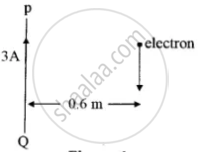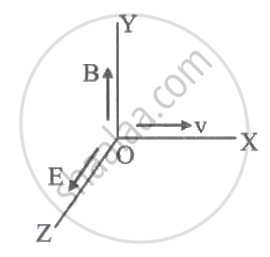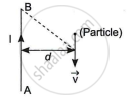Advertisements
Advertisements
Question
A circular coil of N turns and radius R carries a current I. It is unwound and rewound to make another coil of radius R/2, current I remaining the same. Calculate the ratio of the magnetic moments of the new coil and original coil.
Solution
The magnetic moment m of a current loop is the vector whose magnitude is equal to the area of the loop times the magnitude of the current flowing in it i.e.
m =N IA
Where, N = number of turns
Let m1 and m2 be the magnetic moments of circular original coil of radius ‘R’ and new coil of radius ‘R/2’.
Length of wire remains same. Thus,
`N (2piR) = N'(2pi(R/2))`
N' = 2N
Now,
`m_1NIA_1 =NI (pir_1^2) =NIpiR^2`
`m_2 = N'IA_2 = 2NI(pir_2^2) = 2NI(pi(R/2)^2) = 1/2NIpiR^2`
`m_2/m_1 = (1/2)/1 =1/2`
RELATED QUESTIONS
A circular coil carrying a current I has radius R and number of turns N. If all the three, i.e. the current
I, radius R and number of turns N are doubled, then, the magnetic field at its centre becomes:
(a) Double
(b) Half
(c) Four times
(d) One fourth
PQ is a long straight conductor carrying a current of 3A as shown in Figure below. An electron moves with a velocity of 2 x 107 ms-1 parallel to it. Find the force acting on the electron.

A particle of charge -16 x 10-18 C moving with velocity 10 m/s along the X-axis enters a region where a magnetic field of induction B is along Y-axis and electric field of magnitude 104 V/m is along the negative Z-axis. If the charged particle continues moving along the X-axis, the magnitude of B is ____________.

Consider a wire carrying a steady current, I placed in a uniform magnetic field B perpendicular to its length. Consider the charges inside the wire. It is known that magnetic forces do no work. This implies that ______.
- motion of charges inside the conductor is unaffected by B since they do not absorb energy.
- some charges inside the wire move to the surface as a result of B.
- if the wire moves under the influence of B, no work is done by the force.
- if the wire moves under the influence of B, no work is done by the magnetic force on the ions, assumed fixed within the wire.
Show that a force that does no work must be a velocity dependent force.
Two long current-carrying conductors are placed parallel to each other at a distance of 8 cm between them. The magnitude of the magnetic field produced at the mid-point between the two conductors due to the current flowing in them is 300µT. The equal current flowing in the two conductors is ______.
A beam of light travelling along X-axis is described by the electric field Ey = 900 sin ω(t - x/c). The ratio of electric force to magnetic force on a charge q moving along Y-axis with a speed of 3 × 107 ms-1 will be : [Given speed of light = 3 × 108 ms-1]
Write the expression for the Lorentz force on a particle of charge q moving with a velocity `vecv` in a magnetic field `vecB`. When is the magnitude of this force maximum? Show that no work is done by this force on the particle during its motion from point `vecr_1` to point `vecr_2`.
A long straight wire AB carries a current I. A particle (mass m and charge q) moves with a velocity `vec"v"`, parallel to the wire, at a distance d from it as shown in the figure. Obtain the expression for the force experienced by the particle and mention its directions.

Lorentz force in vector form is ______.
